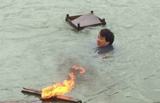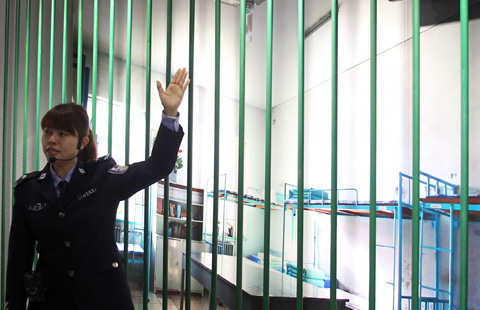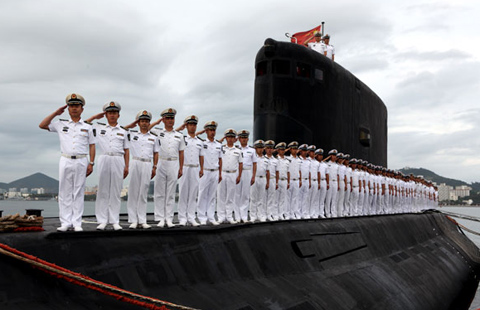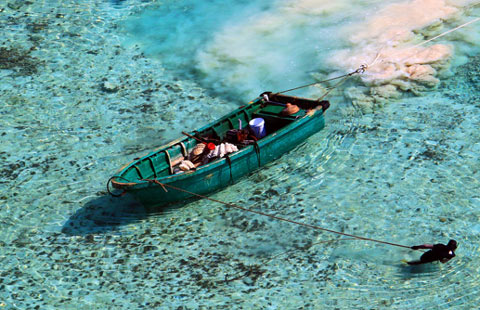True story behind Huangyan Island dispute
(Xinhua) Updated: 2012-05-10 07:41BEIJING - The controversy over a tiny island in the South China Sea has intensified, making it the most serious standoff between China and the Philippines in the sea in recent years.
In early April, the Philippines sent a warship to harass 12 Chinese fishing vessels which sailed into the waters of Huangyan Island to shelter from bad weather.
According to media reports, the Philippines has also notified China on its readiness to raise the issue of the sovereignty of Huangyan Island to international arbitration. In addition, it tried to rename the island and remove the signs and monuments related to China.
Who is the troublemaker
Huangyan Island, a group of reefs and islets about 550 sea miles away from the Hainan Island in south China, has long provided a perfect shelter for fishing ships from nearby islands and the Chinese mainland.
"For many generations we have fished in this water," said Ke Weixiu, a fisherman and native from the port of Tanmen in Hainan.
However, since the 1990s, Chinese fishermen have repeatedly been harassed by Philippine warships.
According to the fishery department under the Ministry of Agriculture, four Chinese fishing boats were intercepted by the Philippine navy in the waters around the island from January to March in 1998 and 51 fishermen on board were detained for about six months.
In May 1999, a Chinese fishing boat was rammed by a Philippine warship and sunk, according to the ministry.
From 2000 to 2011, at least 32 fishing ships, with 439 fishermen on board, were chased, robbed or detained by the Philippine navy.
The latest event occurred in April. Xu Detan, captain of one of the 12 fishing ships harassed, has not recovered from the shocking encounter with the Philippine navy even three weeks after returning home.
"A Philippine warship blocked our entry to the lagoon where we docked our ships," Xu recalled. "We had no choice but to wait inside as they were armed."
On April 10, nine Philippine soldiers, on an inflatable, boarded Xu's ship with seven of them carrying rifles.
"They turned off the radio and satellite positioning system on my ship, searched the whole ship and took pictures while the 16 members of the crew, including me, were standing on the deck under the hot sun for four hours."
Two Chinese Marine Surveillance ships conducting routine patrols in the area later came to the fishermen's rescue and helped Xu and his colleagues return home safely.
"Usually a fishing trip will take 50 days but this time we were forced to cut it short to 25 days," he said.
Philippines' territorial claim is untenable
Until 1997, the Philippines never disputed China's jurisdiction and development of the island. But recently the Philippines has played tricks and triggered disturbances, as well as claiming the island as theirs.
The Philippines says it is the nearest country to Huangyan Island, so it claims the island belongs to it on this premise.
"This theory based on geographic distance for territorial sovereignty has absolutely no basis in international law and judicial practice," according to Zhang Haiwen, deputy director of China Institute for Marine Affairs under State Oceanic Administration.
"There is no such principle in international law that determines territorial ownership by geographic distance," Zhang said, noting that many countries around the world have territories which are far away from their mainland and much closer to other countries.
"For example, the British Channel Islands are less than 12 nautical miles off the French coastline at their closest proximity. Some French territorial islands stretch across the Atlantic, lie close to the Canadian coastline in north America and even in the Pacific. But none of these islands have territorial disputes due to geographic distance," said Zhang.
"The world map would be totally redrawn if the Philippines' theory was upheld," Zhang said.
The Philippines claims that Huangyan Island is in the country's 200-nautical miles-wide Exclusive Economic Zone (EEZ) and says its claim is in line with the United Nations Convention on the Law of the Sea (UNCLOS).
Liu Feng, a researcher with National Institute for South China Sea Studies, said that the UNCLOS has neither the articles to change a country's land territory, nor does it have the authority to allow a country to take another country's territory by the right of the EEZ and the continental shelf.
The Philippines claims that the United States controlled Huangyan Island, thus it has inherited the island's sovereignty and jurisdiction from the US military.
"US forces in the Philippines used Huangyan Island as a shooting range, but the US has never claimed sovereignty over the island. How could the Philippines inherit it? It's ridiculous, " said Zhang Haiwen.
"All the Philippine rhetoric is untenable in terms of international law," said Liu Feng. "So the Philippines wants to take the initiative to stir things up by sending warships to harass Chinese fishermen in Huangyan Island waters and escalate tensions."
- New observation system to boost maritime power
- Canada top college choice of Chinese at foreign high schools
- Former senior police officer arrested
- Beijing courting overseas tourists
- Not schools for scoundrels
- Submariners defy death in the depths
- China pledges $3b investment fund for Central, East Europe
- China's 'saddest city' makes way for water diversion project
- Graft watchdog steps up SOE investigations
- Relocated parents face hard lessons







